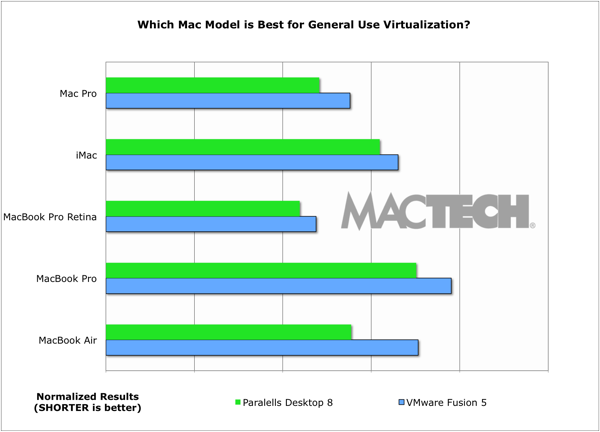Additional Findings
Contents
There are additional tidbits that we learned through the incredibly complex process of testing virtualization products. Here are some additional insights.
64-bit, Virtual Processors, and RAM
We chose 64-bit because it has become the standard on Windows to give users the additional memory they would like. In our experimentations, however, we found the 64-bit default Windows 7 installation was about 2.5 GB larger than the 32-bit in hard disk space. Not a huge deal, but something to note.
These days, the decision is fairly simple. If you have an application that can make use of multiple virtual processors, and this includes 3D Graphics, and your Mac has enough horsepower, then you should use them. Otherwise, it’s not necessary.
Then again, if speed is that important to you, you should ask yourself whether to run the app natively on your Mac instead of in a virtual machine. Sometimes, though, like with some industry-specific software, you may not have an option.
When it comes to RAM, less is often better. You see, the virtualization products need to do a lot with RAM, so only increase it if you really need it and make sure you have enough actual RAM in your hardware. As a general rule, 1GB virtual machines are the way to go for best boot, suspend and resume times. If you are running virtualization, try to have 8GB or more actual RAM in your machine.
Windows 7 or Windows 8?
You may be trying to decide between using Windows 7 and Windows 8. In short, both run well. Let your decision be guided not be speed or performance, but instead by whether you want or need to run one version or the other. Certainly, Windows 7 is likely to be better “vetted” at this point, but we had very few issues with Windows 8 in either virtualization solution.
The Best Macs to Run Virtualization
All the current Macs perform quite well running virtualization, but if you are going to do it a lot, you may want to optimize your hardware. The MacBook Pro Retina was an amazingly good experience. With its high-speed processor, SSD, and lots of RAM coupled with the right level of graphics card, it was a superb experience. Even the MacBook Air did quite well.
The main things to consider are as follows. Try to use an SSD rather than a rotational (mechanical) hard drive. Even the new Apple Fusion drive will likely help (but we didn’t test as they weren’t available at the time we purchased hardware). Get plenty of RAM for your hardware: optimally 8GB or more. If graphics are important, try to go beyond the lightweight graphics hardware in the MacBook Air.
Again, note that the iMac we tested with was the “Late 2011” model, which since it’s what was available when we began testing. The newer iMac has additional options for Apple’s Fusion Drive, as well as higher end graphics cards, which would likely bring the iMac closer to the Mac Pro and MacBook Pro Retina.

